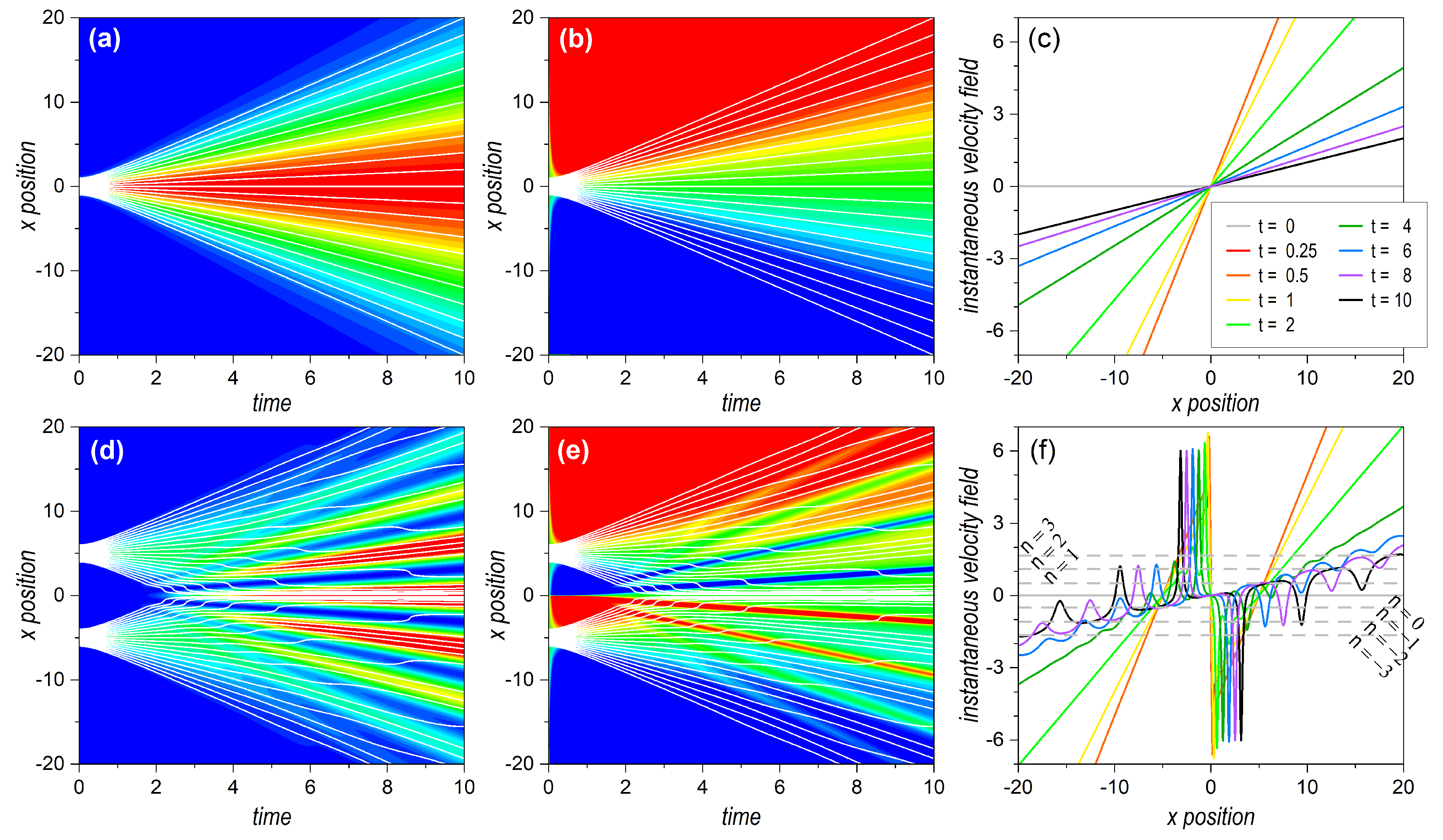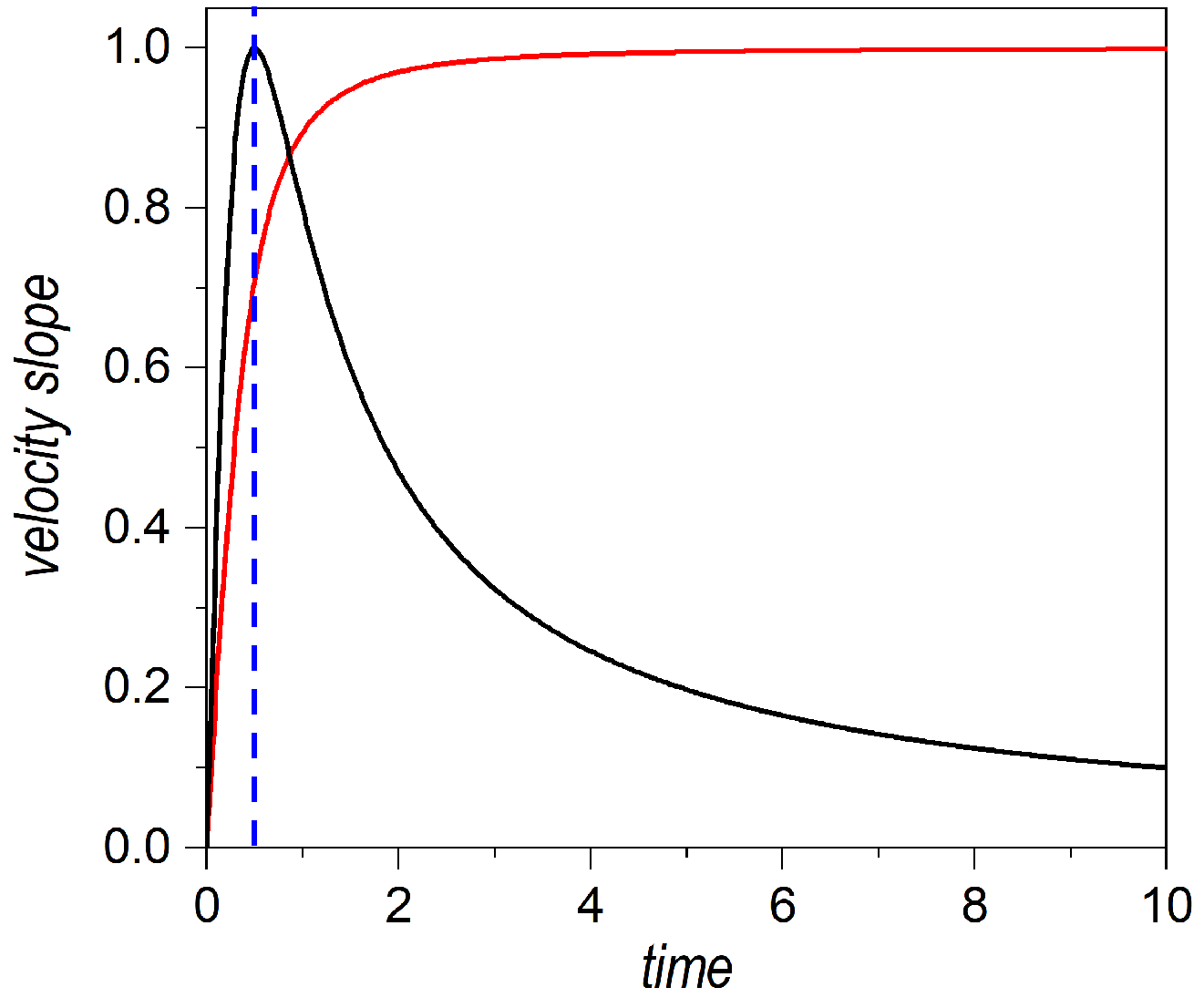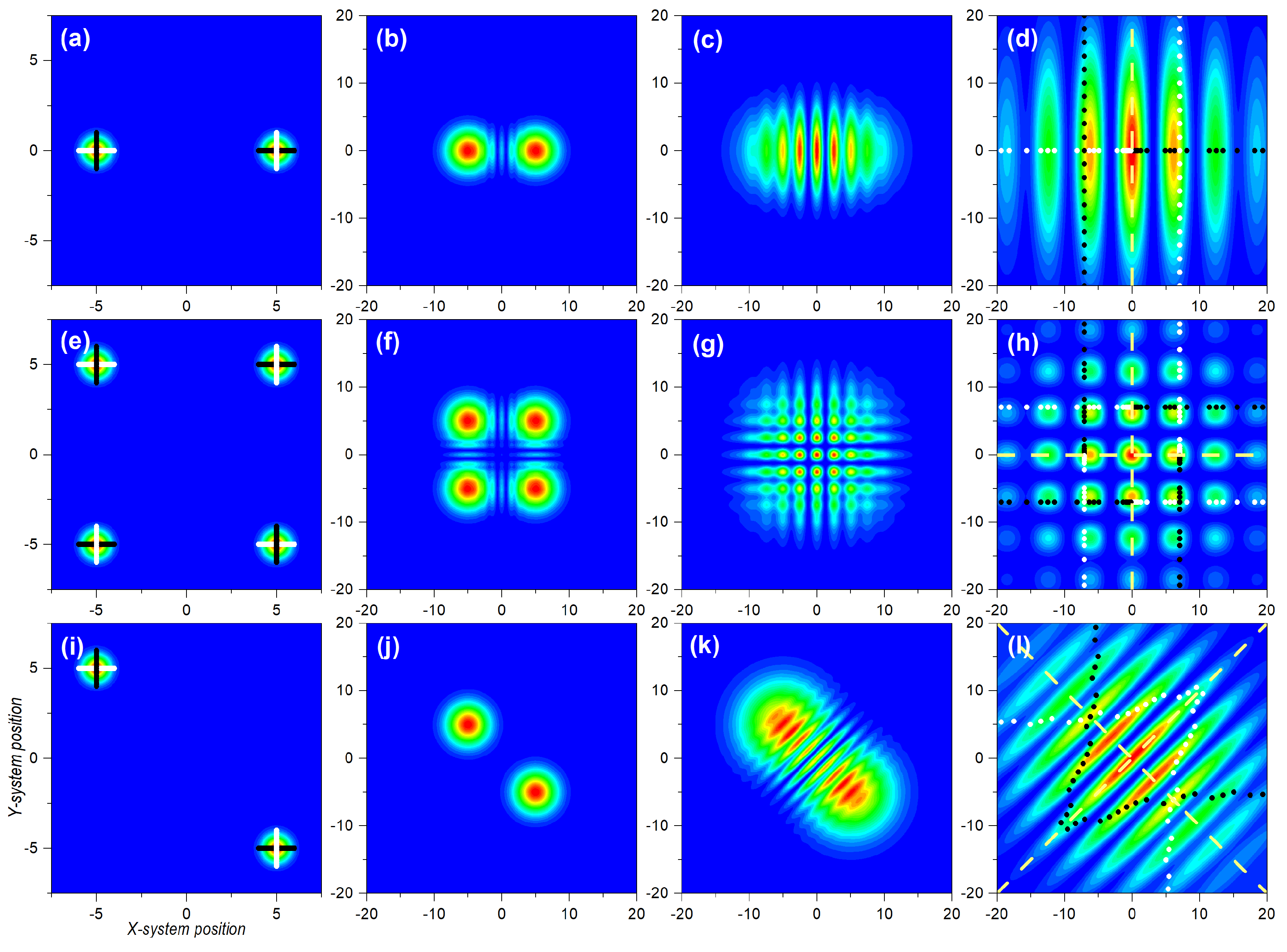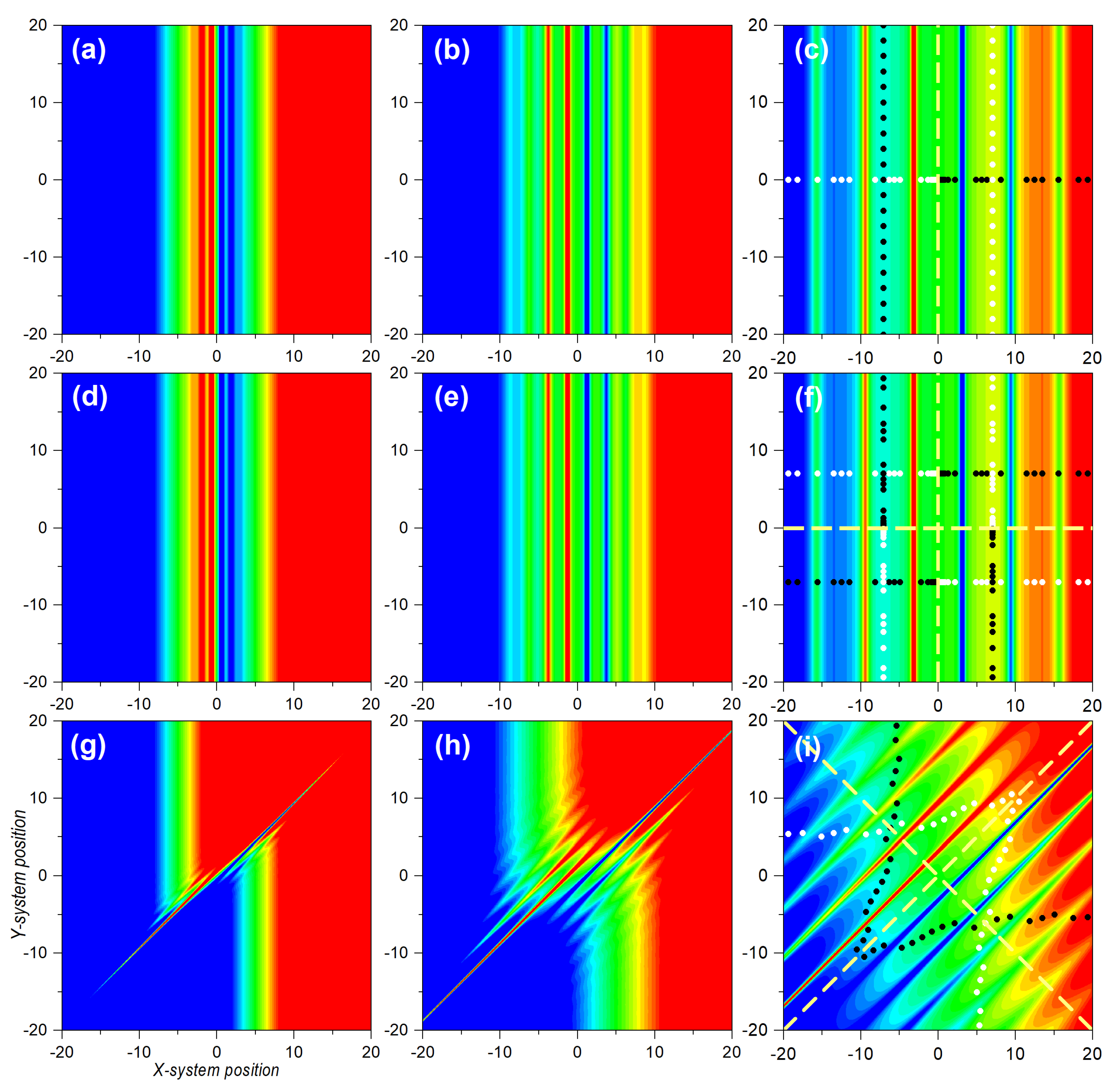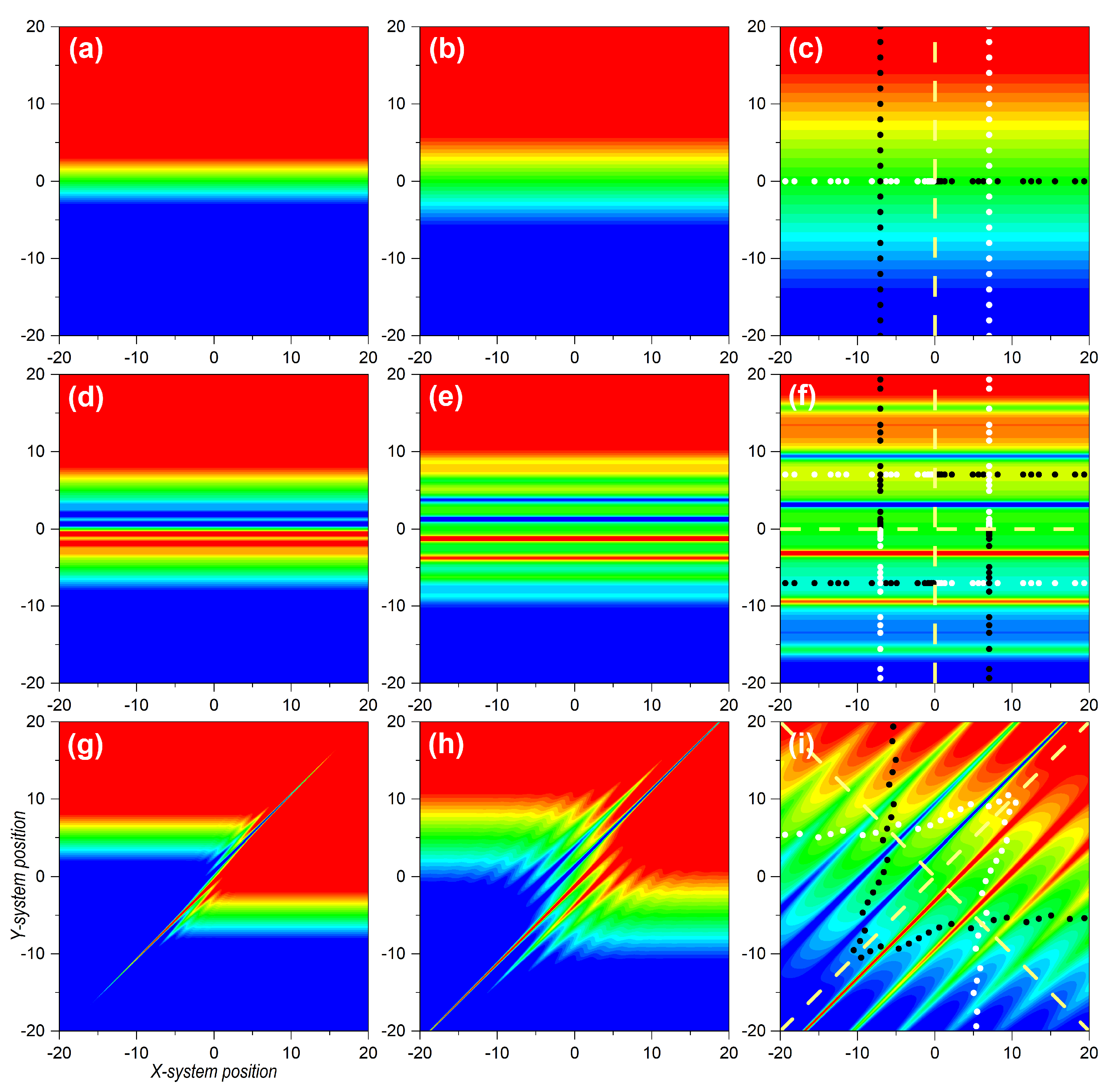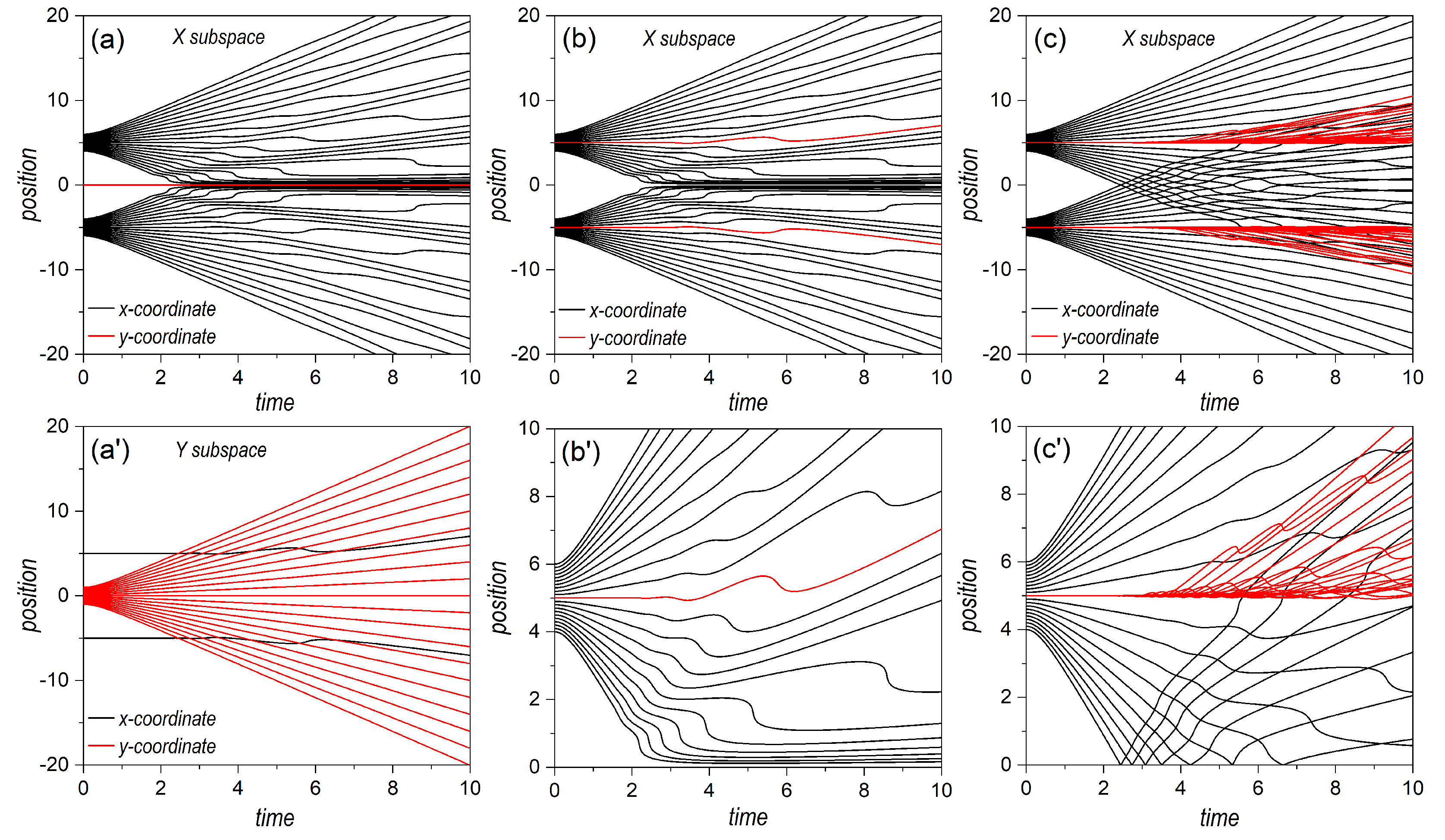3.1. Single-System Dynamical Behaviors
In order to better understand the behaviors exhibited by the separable and entangled bipartite systems, let us first briefly revisit the main dynamical aspects of single localized and delocalized systems, respectively, described by the wave functions (
14) and (
25), and represented in the upper and lower rows of
Figure 1. For the single Gaussian wave packet (
14) (see
Section 2.2.1), the time evolution of the corresponding probability density is represented in the form of a contour plot in
Figure 1a. As is seen, it exhibits a slow dispersion initially until it undergoes a fast increase around
(with the parameters used in the simulations,
), which eventually leads to a linearly increasing dispersion regime. The associated quantum flux is illustrated with the depiction of 21 Bohmian trajectories, which follow Equation (
20) and have equidistant initial positions. We clearly observe a transition from a swarm of nearly parallel trajectories to a linear separation among them, with increasingly faster speeds as the initial condition gets further away from the center of the distribution.
The dynamics described by the probability density are a manifestation of the underlying flux, ruled by the local variations of the phase term that appears in the wave function along its time evolution, as can clearly be seen in Equation (
18). These phase variations, as mentioned before, generate an underlying transverse velocity field, Equation (
19), which gradually changes in time, as can be observed in
Figure 1b in the form of a contour plot, and in
Figure 1c in the form of cross sections at specific times. As seen in
Figure 1c, at a given time, this velocity field increases linearly with
x, pivoting around
; thus, provoking trajectories with
to acquire positive outwards momentum and trajectories with
acquiring negative outwards momentum. This eventually leads to the spread of the whole swarm as time increases. Indeed, as is also seen in
Figure 1c, there is an almost linear increase of the slope of the velocity field from zero, until it reaches a maximum value at
[as can be inferred from Equation (
19)]; then, the slope starts decreasing again, with nearly
, until it approaches zero again.
Such behaviors become more apparent by inspecting the diffusive time-dependent prefactors in Equations (
19) and (
23), for
and
, respectively, which are displayed, in
Figure 2, as functions of time. In the case of the overall velocity field (black line), and taking into account the above-mentioned transition at
, we effectively appreciate two regimes, namely, a nearly uniform acceleration for
and, then, an asymptotic fall with
for
. On the other hand, if we consider the velocity along a given trajectory (red line), the first stage is characterized by nearly uniform acceleration, which provokes fast diffusion of the trajectories, and, then, beyond
, the trajectories acquire a constant speed, proper for uniform motion, as in classical mechanics.
The behaviors that explain the dynamics of a single Gaussian wave packet also hold for a coherent superposition of two of them, like the one described by Equation (
25), provided they are far enough from each other, as is seen at early stages in
Figure 1d,e, compared to
Figure 1a,b, respectively. There is a major difference, though, between the picture offered by the probability density here and the plot of the velocity field. Although the velocity field is zero at
, because of the existence of phase coherence, since the very early stages a sharp spatial division arises, from a dynamical point of view, with two independent velocity fields that do not overlap, but that undergo a sharp shear along the symmetry line
. This behavior is observed until
, when the dispersion of both wave packets is enough to provoke important overlapping between them, analogous to that exhibited by the single wave packet, although with the slope of the velocity field pivoting around the respective centroids. This behavior is better appreciated with the aid of the corresponding trajectories, which show the specific flux evolution at a more local level. These trajectories, superimposed to the density plots, are obtained after numerical integration of Equation (
37) with initial conditions equally distributed within the regions covered by each wave packet. As can be seen, the two swarms of trajectories show a seemingly independent evolution (diffraction) at short times.
At later times, an increasingly prominent overlapping of the two wave packets leads to the appearance of interference traits in the probability density, which are associated with the appearance of regions with relatively constant velocity, interrupted by regions wherein the velocity undergoes sudden changes. The first regions, more stable from a dynamical point of view, enable the accumulation of trajectories along them with nearly the same velocity (on average), which explains the interference maxima. On the other hand, the latter imprint an important shake on trajectories passing by too close to them, which leads them to quickly change from one stable region to the neighboring one, in an inwards staggered motion. This promotion of trajectories from the outer regions of the wave function to the innermost ones eventually leads to a higher population of the corresponding (innermost) interference maxima with respect to the more marginal ones.
Another interesting feature in the long-time regime is that, from two spatially divided dynamical regions, the velocity tends to exhibit a single average slope (interrupted by a series of sudden kicks). However, although this average slope seems to slowly decrease to zero, as we might infer from
Figure 1f, what actually happens is that it converges to an almost constant slope, in compliance with the asymptotic value given by Equation (
39), such that each stable section (between any two kicks) remains at the same height with respect to the central value
. The average value for the height reached by each section is given by Equation (
40), as is indicated by the corresponding horizontal dashed lines. This behavior was actually observed in the experiments with photons performed by Kocsis et al. [
32] more than a decade ago. With the aid of weak measurements, it was possible to measure the transverse momentum, which is a quantity precisely proportional to the Bohmian instantaneous velocity field (although the latter refers to massive particles and, in the case of photons, is related to the transverse component of the wave vector under paraxial conditions [
51,
52]).
3.2. Bipartite-System Dynamical Behaviors
Let us now consider the dynamics generated by bipartite separable and entangled states, and, in particular, how the velocity field that rules the dynamics is influenced by these states. The latter has important implications regarding the spatial distribution of the quantum flux for each subsystem, and, hence, the corresponding (reduced) probability densities and the observation of interference traits. Unlike the analysis presented in
Section 3.1, here, the joint dynamics does not facilitate an analogous space–time description, so we consider a series of illustrative snapshots instead, for both the (joint) probability density and the transverse velocity field. Actually, in the latter case, given that this field depends on both subsystem coordinates
x and
y, we need to consider separate plots for the velocity fields
and
, specified, respectively, by Equations (
55) and (56). Regarding the trajectories, we consider the trajectories projected onto the corresponding subspaces (full higher-dimensional pictures of the trajectories within the joint space are given in the
Supplementary Material). Specifically, in all cases, to investigate the dynamics generated by the corresponding joint wave functions, we considered sets of trajectories with equidistant initial conditions that mapped (initially) either the state of
X or the state of
Y, and that played the role of flow markers. These initial conditions (21 for each wave packet) are uniformly distributed around the center of the wave packets. In the contour plots, these flow markers appear as dots with different colors along the
x and
y directions for better identification in the long-time regime. Thus, at
, they appear as a cross-shaped distribution (see first column panels in
Figure 3), while at
they distribute in different ways (see last column panels in
Figure 3,
Figure 4 and
Figure 5).
In the three cases analyzed, the
X subsystem was described by a two-Gaussian coherent superposition, as given by Equation (
25), as a simplified version of Young’s two-slit experiment. In the case of the
Y subsystem, we firstly considered a localized state, such as the Gaussian wave packet (
14). Accordingly, the joint wave function read as
The initial probability density is represented in
Figure 3a, which effectively shows that, while
Y was localized around
,
X was delocalized between
and
. In
Figure 3b–d we observe the evolution of the joint probability density at
,
, and
, respectively. Due to the factorizability of the state, we could easily identify the different stages of the evolution for
X and
Y with the corresponding cases, shown in
Figure 1a,d. The spatial dispersion of the markers was also in compliance with the corresponding subsystems. If we consider the markers distributed along the
y-direction, their mutual separations increased homogeneously, as this corresponded to the Gaussian state analyzed in
Section 3.1. On the other hand, because of the emergence of interference traits, if we consider the markers along the
x-direction, their distribution was uneven, showing accumulations in the regions covered by maxima and voids in the regions corresponding to interference minima, separated by a distance
at
, according to Equation (
36). These dynamics, though, were governed by the underlying velocity fields, as seen in the upper row panels in
Figure 4 and
Figure 5, for the
and
, respectively. In particular, in
Figure 4a–c, we observe the snapshots for
at
,
, and
, respectively, while the analogous cases for
are represented in
Figure 5a–c. It is worth noting that, unlike the probability density, which was spatially modulated by the Gaussian wave packets, decaying to zero at some point in either direction, the velocity fields remained independent of the complementary coordinate. Thus, at time
t,
kept the same value for a given
x-position, regardless of the value for
y. The same held for
with respect to
x. This is particularly interesting in the case of
X, where its associated velocity field showed, for any value of
y, the periodic alternation of nearly constant regions, in spatial intervals with a value
at
, again in compliance with Equation (
36).
If we consider the case where both subsystems,
X and
Y, are described by identical delocalized superpositions,
the situation turns a bit more complicated, because now the effects of interference emerge along both directions,
x and
y, giving rise to the appearance of a highly organized chessboard-like pattern of local maxima modulated by a two-dimensional Gaussian envelope, as seen in
Figure 3h. This can be inferred from the direct product between Equation (
33) and its equivalent for the
Y subsystem:
A series of snapshots illustrating the trend, until the two-dimensional interference chessboard-like pattern has reached full visibility, is shown in
Figure 3e–h. It can be noticed that, as in the previous case, sets of marker trajectories starting with the same value of
or
do not mix (cross) with trajectories launched with other initial conditions, in spite of the intricate pattern describing the asymptotic behavior of the probability density. The different colors assigned to the markers along the
x and
y directions for the trajectories associated with the four different distributions make evident this behavior. Nonetheless, the dynamical explanation can be found again in the underlying structure displayed by the velocity field, shown in
Figure 4e–h for
, and in
Figure 5e–h for
. As before, the factorizability of the joint state gives rise to two totally independent velocity fields, although both have the same structure, which asymptotically displays the known alternation of stable regions separated by sudden changes in the velocity at even distances of
, for
. According to this velocity pattern, the markers start acquiring an uneven spatial distribution as they become more and more dispersed.
Next, let us take a look at the topology displayed by the trajectories followed by the markers considered in the two cases analyzed so far. A graphical representation on the dynamics for the three types of bipartite states here considered is provided in
Figure 6. In the first column panels, we consider projections of the
x and
y trajectories associated with the wave function (60). In
Figure 6a, we have the
x and
y-components of trajectories specified with initial conditions of the type
for the
X subsystem, with
evenly distributed within the two regions covered by the two wave packets along the
x-direction (see horizontal markers in
Figure 3a). As can be seen, while the
x-component (solid black lines) was in agreement with the behavior exhibited by the analogous one-dimensional system, described by Equation (
25) and discussed in
Section 3.1, the
y-component (red solid line) remained constant [
] at any time. For any other value of
, we would have obtained a similar behavior, with all trajectories showing an identical behavior (for the same initial condition) along
x, but with the whole set moving along the vertical in compliance with the trajectory corresponding to a single Gaussian (see
Supplementary Materials). In
Figure 6a′, however, the behavior is a bit different. In this case, the initial conditions were of the type
, with
evenly distributed within the region covered by a single wave packet along the
y-direction (see markers in
Figure 3a along
y). We observe that the
y-component of the trajectories proceeded in agreement with the behavior studied in
Section 3.1 for a single Gaussian wave packet. However, the
x-component of the trajectories indicated wiggling behavior, since they were not computed at
, but at either
or
, and, hence, there is going to be a contribution to the motion of the
x-component of the velocity field. As a direct consequence of these behaviors, determined by inspecting the trajectory dynamics, either in the
X subspace or in the
Y one, we note that there was a strong connection between separability, a formal aspect, and diffusion, a physical behavior. Specifically, if we consider a slice of the joint probability density at a constant value of
x (or
y), it looks the same at any time as that any other slice taken at another constant value of
x (or
y). The associated (full) velocity field allowed such splittings at a dynamical level, while the trajectories showed local (instantaneous) features of the diffusive process as time proceeded. This consequence was also confirmed in the case wherein
X and
Y were both described by delocalized wave functions, such as in (61). The corresponding trajectories (
x and
y-components, as before) in the
X-subspace are plotted in
Figure 6b. In this case, due to the symmetry along both directions, the sets of trajectories with initial conditions
evolved following the same dynamics as their counterparts with initial conditions
. Consequently, we did not observe any crossing, as before, as can be more clearly seen in the enlargement shown in
Figure 6b′. This resulted in the chessboard-type structure displayed by the joint probability density.
Let us now focus on the entangled state described by the wave function (
43). As seen in
Figure 3i, the initial probability density was only important around
or around
. Physically, this meant that either
X went through slit
A and
Y through
B, or
X through
B and
Y through
B, disregarding any other possibilities. In particular, both subsystems passed through the same slit, which is what the diagonal terms,
or around
, describe. The distance between centroids was, thus, larger than those between any two distributions in the factorizable cases (
for the entangled state, to be compared with
d for the factorizable state). Thus, the effects of the overlapping started becoming apparent at later times (no effect is observed in
Figure 3j, compared with the homologous separable cases shown in
Figure 3b or
Figure 3f). Furthermore, because of the larger distance, the number of interference maxima increased and, hence, the distance between minima decreased by a factor of
. These interferential traits, however, could only be seen along the diagonal joining the centroids, while no interference traits were apparent either along
x or
y (not, at least, in a prominent manner). This translated into interference suppression in the corresponding subspaces or decoherence, discussed in
Section 2.3.
A priori, the above behavior could be considered a minor issue associated with the non-separability of the joint state, since interference was still there, although along the anti-diagonal direction joining the two centroids. However, when we examined the corresponding velocity fields,
or
, displayed in
Figure 4g–i and
Figure 5g–i, respectively, it was not possible to distinguish unique features associated with one direction or the other since early stages of the time evolution. Note that, when we look at these fields along the anti-diagonal direction, they are dramatically interconnected at any time, without allowing us to clearly separate or distinguish two different contributions, remaining invariant along
x or
y, as happened with the factorizable cases. Of course, asymptotically we note that both velocity fields developed stable regions flanked by other regions with sudden changes in the velocity, in compliance with the behavior observed in the probability density. Yet, this is not enough to set an unambiguous separability criterion. Accordingly, the markers disseminated in an uneven way everywhere (see
Figure 5i), which explicitly indicated the strong dependence that the dynamics of
X and
Y had on both coordinates,
x and
y.
If we now consider the trajectories associated with the markers of the entangled state, we find a significant difference with respect to the separable states. The trajectories associated with the
X subsystem are plotted in
Figure 6c (given the symmetry of the state, the trajectories for the
Y subsystem are identical). As can readily be noticed, the renowned Bohmian non-crossing rule breaks down in the reduced subspaces as a consequence of the stretching of the velocity fields along the direction perpendicular to the anti-diagonal. The
x-components of the trajectories launched with
(solid black line) show clearly how, beyond
, crossing started, i.e., they passed through the same position at the same time. The
y-components, on the other hand, instead of evolving along the same path as one of the
x-components, in analogy to the trajectories associated with the two-Gaussian superposition (see
Figure 6b′), also started diverting and crossing the same point at the same time (see enlargement in
Figure 6c′). In this way, trajectories launched from the same subspace slice (i.e., the same constant value for
y, in the case of the
X subsystem) could now explore different regions (slices) of the joint space. This is the reason why simply annihilating the interference term in a reduced model does not ensure that trajectories cross the symmetry axis of the setup, as was shown in [
39], because the dynamics still contain contextual information on the influence of both slits. In order to find the correct answer, the reach of the information about the non-crossed slit must be rather limited, or gradually suppressed, as shown in [
40], in compliance with the evolution here observed for the entangled trajectories.
